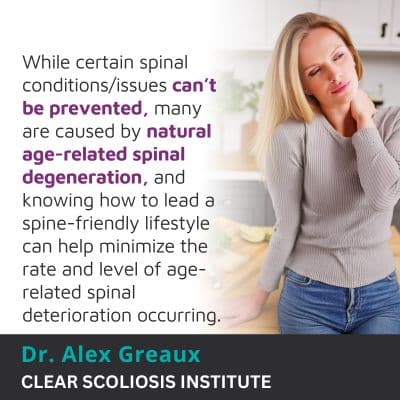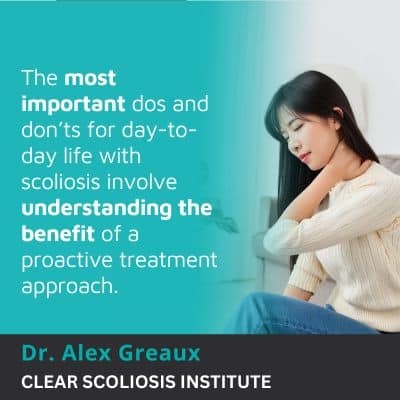
While it’s important for everyone to be mindful of spinal health, for those living with a progressive spinal condition like scoliosis, it can be particularly important. Understanding spinal health and function is the best way to approach living with, and treating, scoliosis.
When it comes to scoliosis dos and dont’s, we’re talking about how best to lead a spine-friendly lifestyle, minimize condition effects, and treat conditions proactively. It’s also important for those recently diagnosed to understand the condition’s progressive nature and treatment needs.
Spinal health is important; the spine allows us to engage in a wide range of movement, stand upright, practice good posture, it protects important organs, and works with the brain to form the central nervous system (CNS) and enable brain-body communication.
Scoliosis causes the spine to lose one or more of its healthy curves as an unhealthy sideways bending and rotating spinal curve develops, introducing uneven forces to the spine, its surroundings, and the entire body.
But what can people with scoliosis do in their daily lives to facilitate the spine’s optimal function over time?

For example, the cumulative effect of certain lifestyle factors can actually contribute to the development of degenerative scoliosis: obesity, low activity levels, chronic poor posture, excessive smoking and/or consumption of alcohol, and not lifting heavy objects properly with the legs, instead of straining the back.
Whether a person has scoliosis or not, these lifestyle factors will impact spinal health, but for those with scoliosis, their spines are already being exposed to adverse spinal tension that’s likely to cause early degenerative changes within the spine.
So let’s address each of these dos and don'ts of life with scoliosis.
Carrying excess weight strains the individual parts of the spine, and particularly when excess weight is carried in the midsection, it’s associated with disrupting spinal biomechanics, causing damage, excessive rates of spinal degeneration, and contributing to the development of a number of spinal conditions/issues (spinal stenosis, osteoarthritis, etc).
In most cases of spinal degeneration, it’s the spinal discs that start to degenerate first, and this is due to their many important roles in maintaining spinal health and function, and they are also the largest structures in the body with no vascular supply.
Disc degeneration, desiccation, bulging, and/or herniated discs are common issues facing people as they age, and for those with scoliosis, it’s not just the spine that’s experiencing uneven forces, but also its surrounding nerves and discs.
Disc health is important and can be affected by a person’s weight.
As the spine is designed to move, leading a sedentary lifestyle is contrary to its natural design and function, and in addition, the spine’s intervertebral discs stay hydrated through movement as it increases circulation and makes nutrients more available for the discs to absorb.
In addition, staying active helps maintain a healthy weight, keeps the spine loose and flexible, and for those undergoing scoliosis treatment, the more flexible the spine is, the more responsive it can be to treatment; as scoliosis progresses, spinal rigidity increases.
So staying active can help minimize the scoliosis effect of increasing spinal rigidity, which can also help with pain management related to a stiff spine and sore, strained, and tight surrounding muscles.
When it comes to spinal support and stabilization, maintaining a strong core is essential so the spine’s surrounding muscles can optimally support and stabilize it; increasing core strength through physical therapy and scoliosis-specific exercise is a key facet of the CLEAR Scoliosis Institute’s treatment approach.
While it’s essential for people with scoliosis to ensure any exercise is safe for their particular curvature/condition type by having it cleared by their treatment provider, staying active is important for keeping the spine strong, its surrounding muscles strong, for keeping the spine loose, flexible, and responsive to treatment.
Most of us have been told to stand up straighter at least once in life, and while the instruction is often appearance-driven, maintaining proper posture is also important for spinal health.
Spinal health is shaped by many factors, one of which is how well it’s aligned, and this means its vertebrae (bones) remain in a neutral and straight alignment; with chronic poor posture, over time, the uneven pressure of holding the spine in an unnatural position can introduce adverse spinal tension.
Spinal health is also shaped by the spine’s ability to maintain its natural curvature at each of the spine’s main sections, and chronic poor posture can disrupt the spine’s natural and healthy curves; functional scoliosis, for example, can develop.
Functional scoliosis isn’t the same as a true structural scoliosis because there is no structural abnormality within the spine itself, nor is there any rotation, but a leg length discrepancy and/or chronic poor posture can, over time, put stress on the spine that’s changed its position and affected its surrounding muscles and ligaments.
Good posture also means keeping the body balanced, evenly distributing its weight over the spine, and evenly distributing the upper body’s weight over the lower body so an economical gait can be maintained.
Excessive consumption of alcohol and/or smoking doesn’t contribute to a healthy lifestyle overall so can impact a person’s health in a number of ways.
In terms of spinal health, these habits can contribute to disc desiccation and the development of degenerative disc disease, which is a contributing factor in the development of degenerative scoliosis and a number of other spinal conditions/issues.
Understanding the ergonomics of heavy lifting is particularly important for those with occupations that involve repeatedly lifting heavy objects.
Repeated tasks that involve heavy lifting can strain the back, its surrounding muscles, and spinal discs that sit between adjacent vertebral bodies.
The lumbar spine is particularly vulnerable to injury and strain as its vertebrae have to support the weight of the trunk, the thoracic and cervical spinal sections above, and they feel the effects of bending, twisting, and lifting motions.
Proper lifting involves moving as close to the load as possible and while keeping the elbows and arms tucked in closely to the body, engage the core so the back is held in a straight and neutral position; bend at the knees while looking up and ahead, and never twist the back while bending or lifting.
For people with scoliosis, because their spines are not aligned and are already being exposed to uneven forces and adverse spinal tension, they can be weaker and more vulnerable to injury, so scoliosis patients have to be particularly careful when lifting heavy objects.

Don’t underestimate how important proactive treatment is for a progressive condition; only proactive treatment has the potential to counteract a progressive nature, and when it comes to scoliosis, as growth triggers progression, childhood scoliosis can progress quickly.
The more scoliosis progresses, the more complex it is to treat, and while there are never treatment guarantees, if a condition is diagnosed early and treatment is started immediately following the diagnosis, treatment success is more likely.
When a proactive conservative treatment plan is customized to address important patient and condition factors, improvements to a person’s daily quality of life can be world towards as spinal health and function are improved through effective treatment.
When it comes to maintaining spinal health, knowing how to lead a spine-friendly lifestyle can have a number of benefits.
For those living with a progressive spinal condition like scoliosis, it’s particularly important because a spine-friendly lifestyle can help make the spine more responsive to treatment and minimize the condition’s effects.
Being mindful of spinal health in daily life means maintaining a healthy weight, activity level, practicing good posture, not consuming excessive amounts of alcohol and/or smoking, and ensuring heavy objects are being lifted in a way that doesn’t strain the spine, its discs, and surrounding muscles.
Being mindful about spinal health with scoliosis also means taking the condition seriously, understanding its effects, and treating it proactively.

CLEAR provides a unique and innovative way of understanding scoliosis. Sign up to receive facts and information you won’t find anywhere else.
